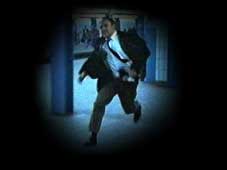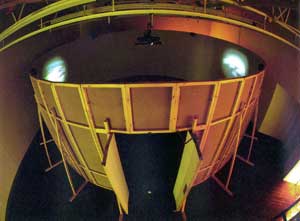Wall of Death
Commissioned by Film and Video Umbrella with Cornerhouse. Wall of Death was shown at Cornerhouse in Manchester in August 1999 and The Paper Bag Factory, London in February 2000.
Custom projector mount designed and engineered by Adrian Fogarthy.
Exhibition supported by Philips.
The piece takes the form of an installation occupying a blacked out space about 9-13m square. Within this a large wooden “Wall of Death” cyclorama (or continuous screen) has been constructed, with a circumference of around 25m, creating a circular space of approximately 7-11m in diameter. Attached to the ceiling at the centre of the cyclorama is a custom built video projector mount which holds two video projectors. These two projectors face outwards and away from each other, focused in opposite directions on the surrounding screen. The mount is driven by an electric motor and revolves at about 8 revolutions per minute. Within the space therefore are projected onto the continuous cyclorama two separate but synched video images directly opposite one another and moving at the same speed across the screen.
These images are created from edited footage of seminal car chase scenes from films such as ‘The French Connection’, ‘Vanishing Point’, ‘The Driver’, and ‘To Live and Die in LA’ . By extracting a number of opposed categories of shot from these films - the footage of the pursued and the footage of the pursuer - two sequences of equal length will be created, the duration of respective shots being altered digitally to create a dynamic synchronization of elements (the exchange of gunfire, reckless cornering, exclamations, revving engines, crashes, etc.) that switches back and forth from image to image as the projections endlessly circulate the cyclorama screen.
Using digital image manipulation software these sequences have been treated to remove from the footage extraneous details to leave just the isolated image of the cars, bikes and figures involved in the chase, the images being projected without any indication of the frame edge. The footage has been adjusted to reduced the resolution of the extracted image and increase its luminance. The whole of each sequence has then been slowed down as will the accompanying sound. This soundtrack is split between the two opposing projections and panned around the space in sync with the images, creating a vivid and dramatic spectacle as the logic of the chase is traded across and around the installation.
In extracting and distilling the chase sequence from this genre of films the ambiguous relationship between spectacle and narrative in the original material is emphasised, isolating the recurring journey of the chase itself - here extended to travel from film to film - so that pursued and the pursuant are locked into an unaltering and unending circular that only ends to begin again.
Wall of Death amplifies the dynamic of the car chase and as with our previous work looks back to the moment before the development of narrative cinema, to the cinema of attractions, the filmic panorama, and the dioramic spectacle.
A catalogue with essays by Sean Cubitt and Rachel Withers is published by Film and Video Umbrella.
“The work is staged as a fairground ‘Wall of Death’, a 360 degree cyclorama onto which are projected various car chase sequences, taken from quintessential ‘chase’ movies of the 1970s.
This architectural feature refers as much to early cinema history as to the thrills of dare-devil fairground spectacle. The exhibitionism of pre-Hollywood cinema and experimentation with panoramic projections from the likes of the Lumiere brothers and other early innovators forms a backdrop to this work.
However, artists Stephen Johnstone and Graham Ellard provide a viewing experience very different to that of cinema. The viewer is integral to the work and it is impossible to watch without moving around the space.
Standing amidst the action, there is no suggested point of view or singular viewing position. The viewer becomes immersed in the spectacle, following the drama around the wall in a futile game of cat and mouse.
The artists, through manipulation of the images, explore the qualities of the car chase as a cinematic convention. ‘The chase’ is shown as undiluted spectacle, seen outside of the film’s wider context of plot or characterisation. The narrative and continuity is disrupted by extracting the two views of pursuer and the pursued and projecting them in opposition. The viewer has to move around the space in order to see both components of the chase. Like unwitting bystanders, we are caught in the cross-fire.
The images have been manipulated in various ways, the artists customising them so that they become something more than re-presented film extracts. Colour saturation and contrast have been increased; sound and movement has been slowed down and the cinematic rectangular frame replaced by vignettes. The slow motion and diffusion of sound, as it tracks the movement of the images around the space, are both seductive and uncanny.
The vignettes are edited in such a way that there is a continuous left to right movement. The chase takes on a lithe and sinuous quality, images floating in and out their indeterminate frames. All these interventions by the artists challenge cinematic conventions whilst scrutinising the qualities and associations of these particular images.
Wall of Death is a Film and Video touring Exhibition, commissioned in association with Cornerhouse. Supported by the Arts Council of England and The London Institute, Central Saint Martins College of Art and Design. The London staging is supported by London Arts Board.”
Steven Bode, director Film and Video Umbrella.
top
work
home
|
|





From top:
Two screen images.
Installation view, interior, Cornerhouse Gallery, Manchester, 1999. Photography Jerry Hardman-Jones.
Installation view, exterior, Cornerhouse Gallery, Manchester, 1999. Photography Jerry Hardman-Jones.
Catalogue, front cover, published by Film and Video Umbrella and Cornerhouse, 1999.
|